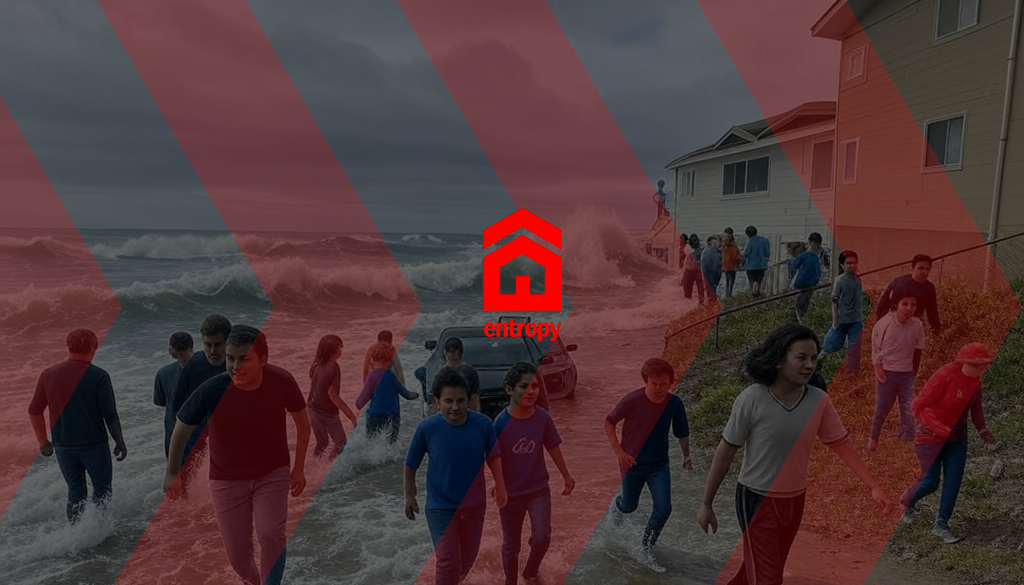Tsunamis are powerful, fast-moving waves caused by big shifts in the Earth – like underwater earthquakes, volcanic eruptions, or landslides. Sometimes even a meteor crash can cause one. The word “tsunami” comes from Japan and means “harbor wave,” which makes sense because these waves often hit the coast hard.
They’re not just one big wave either – tsunamis usually come in a series of waves, and the first one isn’t always the strongest. That’s why it’s super important to stay alert until authorities say it’s safe. If you live near the coast or plan to visit one, knowing what to do before, during, and after a tsunami can literally save your life.
Let’s walk through everything you need to know in a way that makes it easy to remember when it really counts.

Step 1: Know the Warning Signs
If you’re near the ocean and any of the following things happen, take it seriously. A tsunami could be on its way.
🟠 The Water Suddenly Disappears or Rises Quickly
If you’re at the beach and the water pulls way back, exposing the seafloor, that’s a huge red flag. It can look cool, but it’s actually super dangerous. That water is likely building up for a massive return – aka a tsunami wave.
On the flip side, the sea might rise rapidly too. If you notice the shoreline changing fast, don’t wait around to see what happens.
🟠 Earthquake Shaking
If you feel the ground shaking, even for just a few seconds, especially near the coast, there could be a tsunami coming soon. Earthquakes under the sea are one of the biggest causes of tsunamis. Don’t assume it’s over just because the shaking stops.
🟠 A Loud Roar from the Ocean
People who’ve survived tsunamis often say they heard a sound like a freight train or jet engine just before the wave hit. If the ocean starts sounding like a monster is roaring, that’s your cue to run.
Step 2: If You’re on a Boat or in the Harbor
✅ Small Harbor? Get Out or Get Up
If you’re on a small boat and hear a tsunami warning:
- Best Option: Dock and get to high ground ASAP.
- Second Best: If you can’t reach land in time, head far out into the deep ocean. Tsunamis don’t cause much damage in deep water because the waves aren’t as strong out there.
Be aware that once the waves hit shallow areas like harbors or beaches, they get taller and more destructive. Don’t hang out near the shore.
Step 3: If You’re on Land, Move!
✅ Head for Higher Ground Immediately
Don’t wait. Don’t watch. Don’t try to take selfies. Tsunamis move fast—faster than you can run.
- Get to high ground – at least 30 feet (10 meters) above sea level.
- Go as far inland as you can.
- Avoid rivers, creeks, and valleys. Water flows fast through these low spots.
And don’t assume you’re safe after the first wave. Wait for the official “all clear,” which could take hours.
Step 4: If You’re in a Building Near the Coast
✅ Go Up, Not Out
If you’re in a hotel or tall apartment building and can’t get away from the coast in time:
- Move to the third floor or higher.
- Pick a building that’s made of concrete or built to withstand natural disasters.
- Try to find a spot perpendicular to the shore, not facing directly into it.
Being above the wave is way better than trying to outrun it at street level.
Step 5: If You Have No Other Choice
✅ Use a Car as Last Resort Shelter
This is not ideal – but if it’s your only option:
- Get in the car.
- Buckle up.
- Keep the windows closed (you don’t want floodwater rushing in too quickly).
The car might float or be carried by the wave for a while. It’s not the safest choice, but it could give you temporary protection from debris and cold water.
Pro Tips: Tsunami Smarts
Here are some extra nuggets of wisdom that might surprise you—but could really help in a life-or-death moment.
🔺 The First Wave Might Not Be the Worst
A lot of people think once the first wave hits, it’s over. Not true. Later waves can be bigger and more destructive.
🔺 Tsunamis Can Travel Up Rivers and Streams
Even if you’re a few miles inland, if you’re near a river that flows into the ocean, that water can carry the tsunami right to you.
🔺 Flooding Can Go WAY Inland
Tsunami water can travel more than 1,000 feet inland. That’s about the length of three football fields. Don’t assume you’re safe just because you’re not right at the beach.
🔺 Tidal Wave ≠ Tsunami
People mix these up all the time. Tidal waves happen because of gravity (from the moon and sun), and they’re predictable. Tsunamis happen suddenly from geological activity – and they’re not predictable at all.
Be Prepared Before Anything Happens
You can’t plan for exactly when a tsunami will hit, but you can definitely plan for what you’ll do if it does.
✅ Know Your Local Evacuation Routes
Check with your local government or emergency services. Many coastal towns have tsunami evacuation signs. Know where they lead.
✅ Practice Evacuation Drills
It may sound silly, but running through a quick “what if” scenario with your family can save precious time during a real emergency.
✅ Keep a Go-Bag Handy
Have a backpack ready with:
- Water
- Snacks or energy bars
- Flashlight and batteries
- First aid kit
- Whistle
- Phone charger or power bank
- Important documents in a waterproof bag
✅ Stay Tuned to Alerts
Sign up for local emergency alerts. Apps like FEMA, Red Cross Emergency, or NOAA Weather Radio can send tsunami warnings directly to your phone.
Family and Pets Matter Too
- Make sure everyone in your household knows the plan—including kids.
- Keep leashes, pet carriers, and some food ready for pets.
- If you’re separated, have a meeting spot set up in advance.
After the Tsunami: What to Do
Surviving the wave is just the first part. Once the danger passes:
✅ Stay Where It’s Safe
Don’t rush back to the coast. There may be more waves coming, or the area could still be flooding.
✅ Watch Out for Debris and Power Lines
Tsunamis can tear up buildings, roads, and power lines. Be cautious of unstable structures or hidden dangers in the water.
✅ Help Others If You Can
Check on neighbors, especially the elderly, children, or people with disabilities.
✅ Listen to Emergency Broadcasts
Officials will tell you when it’s safe to return. Don’t rely on rumors.
Final Thoughts
Tsunamis are rare, but when they do strike, they’re fierce. The good news is that with a little knowledge and some preparation, you can dramatically increase your chances of surviving.
Remember:
- Don’t wait – act fast.
- Don’t watch – run to safety.
- Don’t return – until you get the all-clear.
You’ve got this. Knowing what to do is the first step to staying safe. Share this info with your family and friends – because when the water comes rushing in, the best thing you can have is a plan.etailed and region-specific instructions, refer to the National Weather Service and the Federal Emergency Management Agency (FEMA). Stay informed, stay prepared, and stay safe.
Disclaimer: This advice is general in nature and may not address every specific situation you encounter. Always refer to local authorities and weather services for the most accurate and relevant guidance during an emergency.
Make sure to check out more articles in our News & Views section. Feel free to reach out any time to see how Entropy Survival can help you prepare you and your family for any disaster or survival scenario.
